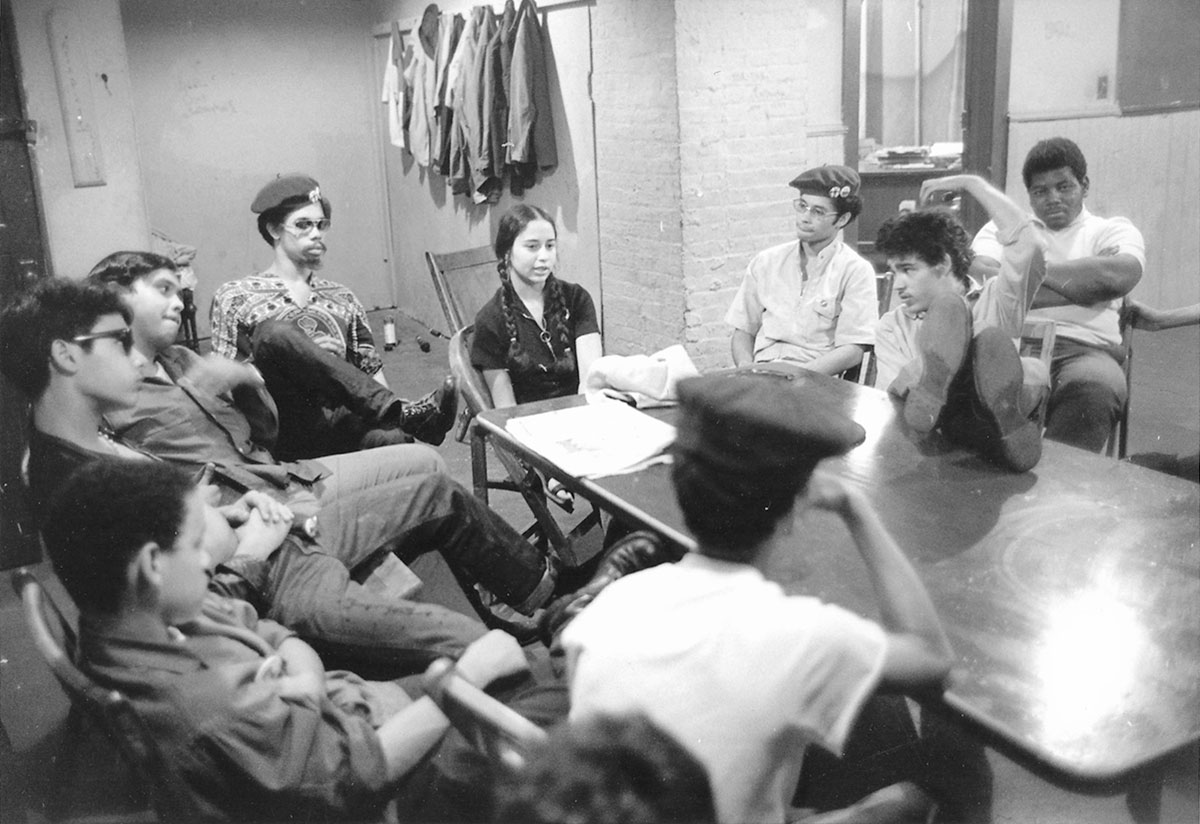Iris Morales Leads Political Education Class

Date: undated, c. 1969-1971
Caption: This photo captures Young Lords Party members sitting together in a circle during a political education class. Iris Morales (seated at the head of the table) leads the group discussion about that week’s assigned texts.

Born in 1948, Iris Morales was the child of Puerto Rican migrants to New York. Morales’ political development began early as she recognized the barriers her parents faced in trying to access their rights as citizens. “As a child of migrants,” she would later recall, “we don’t speak the language, we don’t know how to navigate the court system, we don’t know how to access our rights.” In addition to her parents’ struggle in New York, Morales also learned the depths of inequality and segregation by watching “the horrific TV images of the civil rights movement.” She discussed the movement with her friends in the Student Nonviolent Coordinating Committee (SNCC), and acted in a school play produced by an NAACP youth group. She also participated in the 1964 student boycott of New York City’s schools, and worked as a tenants’ rights organizer.1
Iris Morales saw parallels between Puerto Rican and Black New Yorkers’ struggles against segregation and believed in a common cause between the two groups. When Morales arrived as a freshman at City College, she joined ONYX, the Black student organization, because there was no Puerto Rican political organization on campus. However, it didn’t take long for Morales to join a group that led to the creation of Puerto Ricans Involved in Student Action, which sought to establish Puerto Rican studies in the school.2
Morales brought these experiences and her organizing talents to the Young Lords Party. She and other Young Lords members, including Denise Oliver, also had experience as educators in other spaces. Morales played a critical role in the group’s political education program. As another Young Lord recalled, Morales “was sharp, she was able to absorb ideas and break them down so that anyone could understand them.”3 That is, she was a capable teacher. Her ability to make knowledge accessible was critical for the Young Lord’s political education classes.
In her groundbreaking history on the Young Lords Party, historian Johanna Fernández writes that “For many Puerto Ricans, education had been fraught with trauma and social rejection they endured as children in New York public schools. The sense that it was meaningless led many members of the organization to drop out of school.”4 As a result, many of the party’s members were illiterate. However, Morales, in collaboration with Juan Gonzalez, established a political education program that combined college-level reading material on structural inequality with discussions of students’ own shared experiences. Members recounted being demeaned for speaking Spanish or tokenized in other educational programs. Participants analyzed these experiences together.5 The Young Lords created a collective educational space outside of traditional classrooms, helping individual participants and strengthening the group’s political awareness. As Johanna Fernandez writes, “the organization became a formidable school in and of itself.”6
-
Johanna Fernández, The Young Lords: A Radical History (Chapel Hill: University of North Carolina Press, 2019), 252-253. ↩︎
-
Fernández, The Young Lords, 253. ↩︎
-
As quoted in Fernández, The Young Lords, 203. ↩︎
-
Fernández, The Young Lords, 203. ↩︎
-
Fernández, The Young Lords, 203. ↩︎
-
Fernández, The Young Lords, 203. ↩︎
Categories: Manhattan, Bronx, community activism
Tags: racist segregation, Latinx people, Black people, protest, curriculum, organizing, autonomous educational spaces, women's activism
This item is part of "Denise Oliver and the Women of the Young Lords Party" in "Black and Latina Women’s Educational Activism"
Item Details
Date: undated, c. 1969-1971
Creator: Michael Abramson
Source: Reprinted in Johanna Fernández, The Young Lords: A Radical History (Chapel Hill: University of North Carolina Press, 2019)
Copyright: Under copyright, used with permission. Courtesy of Johanna Fernandez. Used with permission.
How to cite: “Iris Morales Leads Political Education Class,” Michael Abramson, in New York City Civil Rights History Project, Accessed: [Month Day, Year], https://nyccivilrightshistory.org/gallery/iris-morales.
Questions to Consider
- Does the political education class in the picture look like classrooms in your school? What’s similar? What’s different?
- What made the Young Lords’ political education classes different than traditional schoolrooms? Why might that have been effective?
- As noted above, many of the Young Lords Party members were illiterate, what resources did the party provide to its members so they could meaningfully participate in these political education classes? How did creating educational spaces that responded to the needs of their learners help the party’s work?
- If you were working with your peers to create a learning space for one another, what would it look like? What would you want to learn? How would you learn it?
References
How to Print this Page
- Press Ctrl + P or Cmd + P to open the print dialogue window.
- Under settings, choose "display headers and footers" if you want to print page numbers and the web address.
- Embedded PDF files will not print as part of the page. For best printing results, download the PDF and print from Adobe Reader or Preview.
